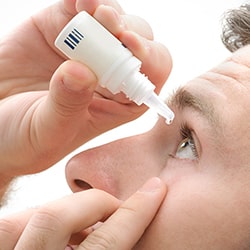Dry Eye
What is dry eye?
Dry eye is a term used when the eye feels dry, gritty and sore, but not painful. Despite the name, the irritation caused by dry eye may trigger excessive tears. It may be caused by ageing, eye allergies, diseases such as rheumatoid arthritis that disrupt the normal production of tears, some medicines such as antihistamines, benzodiazepines, diuretics, oral contraceptives, antipsychotics and tricyclic antidepressants, and environmental factors such as low humidity.
Open air, wind and sunlight may worsen dry eye. Dry eye may also redden the eyes, but it requires different treatment from the condition known as ‘red eye’.
Dry eye symptoms should be treated because if the eye is not properly lubricated, foreign material not washed away from the eye may lead to eye damage, infection and ulceration.
How can you help prevent dry eye?
You can help prevent dry eye by:
- protecting your eyes from sun and wind by wearing wrap-around sunglasses;
- avoiding irritants such as smoke, dust, cosmetics and chlorine;
- avoiding air conditioners that dry the air;
- avoiding hair dryers;
- using a humidifier at home; and
- using artificial tears or lubricant regularly.
Artificial tears and lubricants are available as eye drops, gels and ointments. Eye drops are ideal for regular use during the day, and can be used as often as you need them. Ointments or gels may be used at night, or for severe daytime symptoms. Some people can be allergic to the preservative used in eye drops; if so, preservative-free preparations are available, although they are more expensive.
You should always wash your hands before instilling eye drops or applying eye ointment or gel. Be careful not to touch the eye with the container, as the contents may become contaminated with bacteria and later cause infection. Discard any unused medication once the packet has been open for 4 weeks.
When should you seek medical advice about dry eye?
You should seek medical advice if:
- the eye is painful;
- eyesight is deteriorating;
- vision is blurred;
- the eye is red;
- the eye has a coloured discharge;
- the eyelids are stuck together on waking;
- you have glaucoma;
- you have rheumatoid arthritis;
- you have diabetes; or
- the dry eye persists for 7 to 10 days, despite treatment.
Eye lubricants successfully alleviate the symptoms of dry eye but do not cure the cause. You should see your doctor urgently if the eye becomes red and painful and/or your vision becomes blurry.
Can’t find what you’re looking for? Ask our Eye Care Experts!









